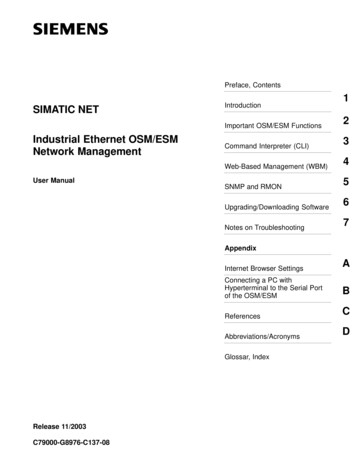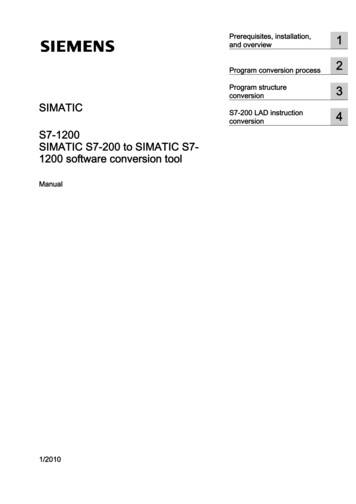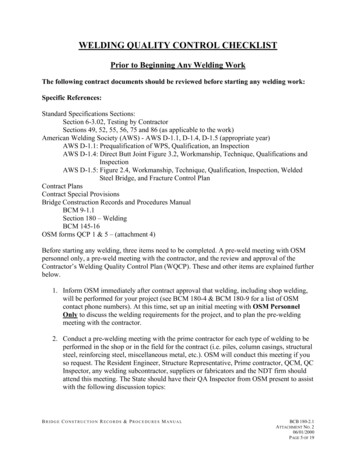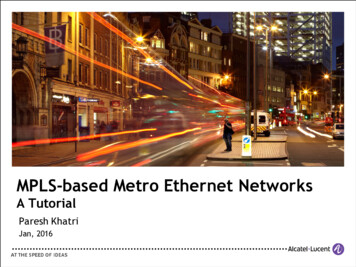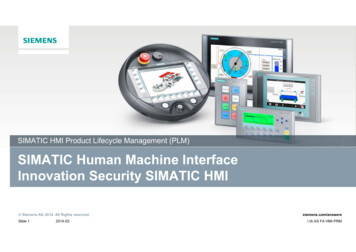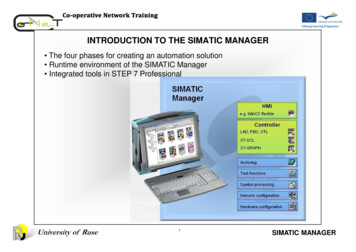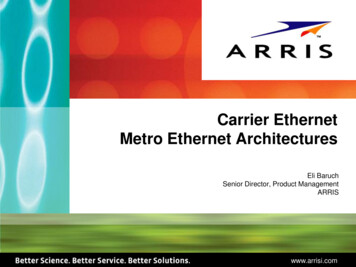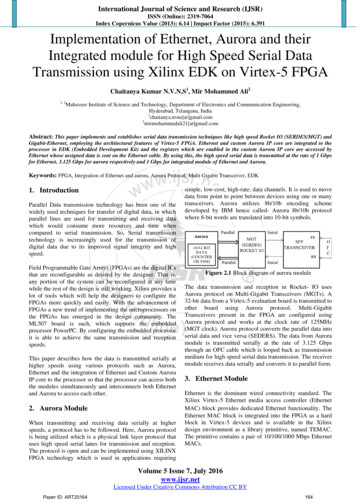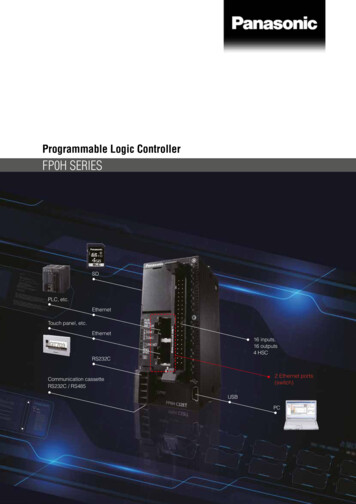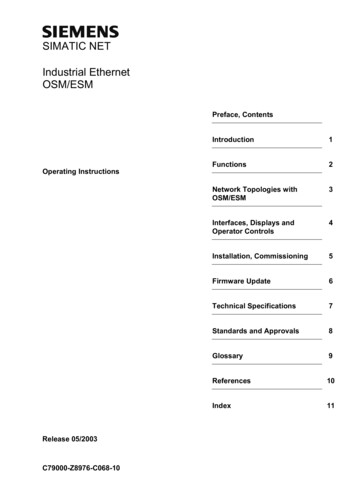
Transcription
SIMATIC NETIndustrial EthernetOSM/ESMPreface, ContentsOperating InstructionsRelease Network Topologies withOSM/ESM3Interfaces, Displays andOperator Controls4Installation, Commissioning5Firmware Update6Technical Specifications7Standards and Approvals8Glossary9References10Index11
Classification of Safety-Related NoticesThis document contains notices which you should observe to ensure your ownpersonal safety, as well as to protect the product and connected equipment. Thesenotices are highlighted in the manual by a warning triangle and are marked as followsaccording to the level of danger:!Dangerindicates that death or severe personal injury will result if proper precautions are nottaken.!Warningindicates that death or severe personal injury can result if proper precautions are nottaken.!Cautionwith warning triangle indicates that minor personal injury can result if properprecautions are not taken.Cautionwithout warning triangle indicates that damage to property can result if properprecautions are not taken.Noticeindicates that an undesirable result or status can occur if the relevant notice isignored.Notehighlights important information on the product, using the product, or part of thedocumentation that is of particular importance and that will be of benefit to the user.Copyright Siemens AG 2000/02, All rights reservedThe reproduction, transmission or use of this document or itscontents is not permitted without express written authority.Offenders will be liable for damages. All rights, including rightscreated by patent grant or registration of a utility or design, arereserved.Siemens AGAutomation and DrivesPostfach 48 48, D-90327 NuernbergSiemens AktiengesellschaftDisclaimerWe have checked the contents of this manual for agreement withthe hardware and software described. Since deviations cannot beprecluded entirely, we cannot guarantee full agreement. However,the data in this manual are reviewed regularly and any necessarycorrections included in subsequent editions. Suggestions forimprovement are welcome.C79000-Z8976-C068-10 Siemens AG 2001/2003Technical data subject to change.Printed in the Federal Republic of Germany
TrademarksSIMATIC , SIMATIC NET , SINEC and SIMATIC NET Networking for Industry are registered trademarks of Siemens AG.Third parties using for their own purposes any other names in this document whichrefer to trademarks might infringe upon the rights of the trademark owners.Safety Instructions Regarding your ProductBefore you use the product described here, read the safety instructions belowthoroughly.Qualified PersonnelOnly qualified personnel should be allowed to install and work on this equipment .Qualified persons are defined as persons who are authorized to commission, toground, and to tag circuits, equipment, and systems in accordance with establishedsafety practices and standards.Correct Usage of Hardware ProductsPlease note the following regarding the correct usage of hardware products:CautionThis device and its components may only be used for the applications described inthe catalog or the technical description, and only in connection with devices orcomponents from other manufacturers which have been approved or recommendedby Siemens.This product can only function correctly and safely if it is transported, stored, set up,and installed correctly, and operated and maintained as recommended.Before you use the supplied sample programs or programs you have written yourself,make certain that no injury to persons nor damage to equipment can result in yourplant or process.EU Directive: Do not start up until you have established that the machine on whichyou intend to run this component complies with the directive 89/392/EEC.
Correct Usage of Software ProductsPlease note the following regarding the correct usage of software products:CautionThis software may only be used for the applications described in the catalog or thetechnical description, and only in connection with devices or software products fromother manufacturers which have been approved or recommended by Siemens.Before you use the supplied sample programs or programs you have written yourself,make certain that no injury to persons nor damage to equipment can result in yourplant or process.Prior to StartupBefore putting the product into operation, note the following warning:CautionPrior to startup you must observe the instructions in the relevant documentation. Forordering data of the documentation please refer to the catalogs or contact your localSIEMENS representative.Copyright Siemens AG 2000/02, All rights reservedThe reproduction, transmission or use of this document or itscontents is not permitted without express written authority.Offenders will be liable for damages. All rights, including rightscreated by patent grant or registration of a utility or design, arereserved.Siemens AGAutomation and DrivesPostfach 48 48, D-90327 NuernbergSiemens AktiengesellschaftDisclaimerWe have checked the contents of this manual for agreement withthe hardware and software described. Since deviations cannot beprecluded entirely, we cannot guarantee full agreement. However,the data in this manual are reviewed regularly and any necessarycorrections included in subsequent editions. Suggestions forimprovement are welcome.C79000-Z8976-C068-10 Siemens AG 2001/2003Technical data subject to change.Printed in the Federal Republic of Germany
PrefacePrefacePurpose of the Operating InstructionsThese Operating Instructions provide you with support during configuration,commissioning, and troubleshooting of networks with Industrial Ethernet OSMs(Optical Switch Module) and Industrial Ethernet ESMs (Electrical Switch Module).The PackageThe OSM/ESM includes the following components: OSM/ESM device 6-pin plug-in terminal block for connection of the power supply and the signalingcontact One or two 6-pin plug-in terminal blocks for OSMs/ESMs with digital inputs Kit for wall mounting or mounting in 19" cubicle Product information bulletin CDInstalling an OSM/ESM Follow the instructions in Chapter 5 of these operating instructions.Industrial Ethernet OSM/ESMC79000-Z8976-C068-101
PrefaceValidity of the Operating InstructionsThese operating instructions are valid for the following devices: OSM ITP62 OSM ITP62-LD OSM ITP53 ESM ITP80 OSM TP62 ESM TP80 OSM BC08 OSM TP22 ESM TP40Further DocumentationThe OSM/ESM Network Management manual /1/ describes how to operate theOSM/ESM with network management.The "SIMATIC NET Industrial Twisted Pair and Fiber Optic Networks" manual /2/contains further information if you want to connect the OSM/ESM to other SIMATICNET network components (for example OLM, ELM) or if you want to connect entirenetwork segments to an OSM/ESM.The "Triaxial Networks for Industrial Ethernet" manual /3/ contains instructions oncreating triaxial networks that you can connect via an ELM to an OSM/ESM.Finding InformationTo help you to find the information you require more quickly, the manual includesnot only the table of contents but also the following sections in the Appendix: Glossary Index2Industrial Ethernet OSM/ESMC79000-Z8976-C068-10
PrefaceGuide to the ManualTo help you to find specific information quickly, these operating instructions includethe following parts: At the front of the operating instructions you will find a complete table ofcontents. The chapters have headings in the left margin with an overview of the contentsof the paragraphs in the section. Following the appendix, you will find a Glossary in which the most importantspecialist terms used in the instructions are defined. At the back of the operating instructions, you will find an index with which youcan find topics quickly.AudienceThese Operating Instructions are intended for staff involved in configuration,commissioning, and troubleshooting networks with Industrial Ethernet OSMs(Optical Switch Module) and Industrial Ethernet ESMs (Electrical Switch Module).Personnel Qualification RequirementsOnly qualified personnel should be allowed to install and work on this equipment.Qualified personnel as referred to in the operating instructions or in the warningnotes are defined as persons who are familiar with the installation, assembly,startup and operation of this product and who possess the relevant qualificationsfor their work, e.g.: Training in or authorization for connecting up, grounding or labeling circuits anddevices or systems in accordance with current standards in safety technology; Training in or authorization for the maintenance and use of suitable safetyequipment in accordance with current standards in safety technology; First Aid qualification.Standards and ApprovalsThe OSM /ESM meets the requirements for the CE mark. You will find detailedinformation on the existing approvals and certifications in the Appendix in thismanual.Industrial Ethernet OSM/ESMC79000-Z8976-C068-103
Contents1Introduction. verview of the Variants of the OSM/ESM . 7OSM ITP62 . 7OSM ITP62-LD . 9OSM ITP53 . 11ESM ITP80 . 13OSM TP62 . 15ESM TP80 . 17OSM BC08. 19OSM TP22 . 21ESM TP40 . 232Functions . 253Network Topologies with OSM/ESM. 284563.1Bus Structure . 293.2Redundant Ring Structure . 313.3Redundant Coupling of Network Segments . 333.4Compatibility of OSM Version 2/ESM with OSM/ORM Version 1 . 373.5Coupling Network Segments . 41Interfaces, Displays and Operator Controls . P Ports . 44ITP Ports . 44TP Ports . 44Properties of the TP/ITP Ports. 45FO Ports . 47Standby-Sync Port. 48Serial Interface. 49Signaling Contact/Terminal Block for Attaching the Power Supply. 50Digital Inputs . 534.24.2.14.2.24.2.34.2.4Displays and Operator Controls . 54LED Display "Status" . 54LED "Power" . 56Port LEDs . 58Operator Controls . 60Installation, Commissioning, Cleaning and Maintenance. 625.1Unpacking, Checking the Consignment . 635.2Installation. 645.3Cleaning. 715.4Maintenance . 72Firmware Update . 73Industrial Ethernet OSM/ESMC79000-Z8976-C068-104
Introduction7Technical Specifications . 788Standards and Approvals . 849Glossary . 8810References . 9111Index. 93Industrial Ethernet OSM/ESMC79000-Z8976-C068-105
IntroductionIntroduction1The switching technology of the Industrial Ethernet OSM Version 2/ESM(Optical/Electrical Switching Module) allows the structuring of Ethernet networkswith large spans and large numbers of nodes. It simplifies network configurationand network expansions. The OSM Version 2/ESM are simply called OSM/ESM inthe rest of this manual.The OSMs have both electrical ports and additional FO ports via which several ofthese devices can be interconnected to form an optical bus or ring configuration.ESMs only have electrical ports.DTEs, other OSMs/ESMs or complete network segments operating at 10 or 100Mbps can be connected to the electrical autonegotiation (autosensing) ports of theOSM/ESM. The transmission rate is detected automatically.To increase availability, ring configurations can be created with OSMs or ESMs. Todo this, OSMs or ESMs are first connected together to form a bus using their ringports. The ends of the bus are closed to form a ring by an OSM or ESM operatingin the Redundancy Manager mode (RM mode).The OSM or ESM operating in the RM mode monitors the attached bus and allowsa connection through it if it detects an interruption on the attached bus; in otherwords, it reestablishes a function bus. Reconfiguration is completed within 0.3s. AnOSM/ESM is switched over to the RM mode using a DIP switch on the device.The redundant standby coupling allows the redundant coupling of OSM/ESM orOLM rings. To do this, two OSM/ESMs (one operating in standby mode) areconnected via their standby-sync ports.With the ITP variants of the OSM/ESM, the DTEs are connected using sub-Dfemale connectors. This connector technology allows direct links over distances upto 100 m. With the TP variants, the DTEs are connected using RJ-45 jacks.The Version 2 OSMs are compatible with the previous OSM variants (6GK 11050AA00) and ORM (6GK1105-1AA00) and can, for example, be mixed with these inan optical ring.This manual describes the functions of the OSM/ESM available without usingnetwork management. The OSM/ESM Network Management user manual /1/describes the additional options available if you use network management. You willfind this manual on the CD accompanying every OSM/ESM or you can downloadthe manual from the Web in Siemens Customer Support under entry /86772036Industrial Ethernet OSM/ESMC79000-Z8976-C068-10
Introduction1.11.1.1Overview of the Variants of the OSM/ESMOSM ITP62Possible AttachmentsThe OSM ITP62 allows attachment of up to 6 DTEs or network segments using theITP connector. By coupling an OSM via ports 7 and 8 it is possible to create opticalbus and ring structures. The OSM TP62 can be coupled with other OSM TP62,OSM TP22, OSM ITP53, OSM ITP62, and OSM BC08 modules via the opticalports.The OSM ITP62 also has eight digital inputs. The states of the inputs are availablein a management information base (MIB) and can be read using an SNMP getrequest. Depending on the configuration of the device, changes at these inputs canalso trigger the sending of E-mails, SNMP traps and/or entries in the log of theOSM. The use of these functions is described in the OSM/ESM NetworkManagement User Manual /1/.Figure 1: OSM ITP62Industrial Ethernet OSM/ESMC79000-Z8976-C068-107
IntroductionProperties of the OSM ITP62Electrical ports6 x 10/100 Mbpsautonegotiation/autocrossover portsITP connectors (sub-D 9-pin female)Optical ports2 x 100 Mbps FO ports (full duplex)BFOC female connectorsMaximum distance between two OSMs3000 m (multimode graded-index fiber)Maximum ring span with 50 OSMs150 kmDigital Inputs8 x DC 24VNoteIndustrial Ethernet OSM ITP62 is available in two versions:8 OSM ITP62 with eight digital inputs:The eight digital inputs are connected over two plug-in 6-pin terminal blocks onthe top of the device. To display the status of these inputs using the eightdevice LEDs, there is an additional display mode known as the "Input Status"that is selected using a third mode LED. OSM ITP62 without digital inputs:There are no digital inputs and the "Input Status" display mode is not available.The operating states are displayed by two mode LEDs.Industrial Ethernet OSM/ESMC79000-Z8976-C068-10
Introduction1.1.2OSM ITP62-LDPossible AttachmentsThe OSM ITP62-LD allows attachment of up to six DTEs or network segmentsusing the ITP connector. By coupling an other OSM ITP62-LD modules via ports 7and 8 it is possible to create optical bus and ring structures.The OSM ITP62-LD also has eight digital inputs. The states of the inputs areavailable in a management information base (MIB) and can be read using anSNMP get request. Depending on the configuration of the device, changes at theseinputs can also trigger the sending of E-mails, SNMP traps and/or entries in the logof the OSM. The use of these functions is described in the OSM/ESM NetworkManagement User Manual /1/.Figure 2: OSM ITP62-LDIndustrial Ethernet OSM/ESMC79000-Z8976-C068-109
IntroductionProperties of the OSM ITP62-LDElectrical ports6 x 10/100 Mbpsautonegotiation/autocrossover portsITP connectors (sub-D 9-pin female)Optical ports2 x 100 Mbps FO ports (full duplex)BFOC female connectorsMaximum distance between two OSMs26 km (monomode fiber)Maximum ring span with 50 OSMITP62-LD1300 kmDigital Inputs8 x DC 24VNoteIndustrial Ethernet OSM ITP62-LD is available in two versions:10 OSM ITP62-LD with eight digital inputs:The eight digital inputs are connected over two plug-in 6-pin terminal blocks onthe top of the device. To display the status of these inputs using the eightdevice LEDs, there is an additional display mode known as the "Input Status"that is selected using a third mode LED. OSM ITP62-LD without digital inputs:There are no digital inputs and the "Input Status" display mode is not available.The operating states are displayed by two mode LEDs.Industrial Ethernet OSM/ESMC79000-Z8976-C068-10
Introduction1.1.3OSM ITP53Possible AttachmentsThe OSM ITP53 allows attachment of up to five DTEs or network segments usingthe ITP connector. By coupling an OSM via ports 7 and 8 it is possible to createoptical bus and ring structures. The OSM TP53 can be coupled with other OSMTP53, OSM TP62, OSM ITP22, OSM ITP62, and OSM BC08 modules via theoptical ports.The additional FO port of the OSM ITP53 (port 1) also allows redundant coupling ofrings via fiber-optic cable (see Section 3.3).The OSM ITP53 also has eight digital inputs. The states of the inputs are availablein a management information base (MIB) and can be read using an SNMP getrequest. Depending on the configuration of the device, changes at these inputs canalso trigger the sending of E-mails, SNMP traps and/or entries in the log of theOSM. The use of these functions is described in the OSM/ESM NetworkManagement User Manual /1/.Figure 3: OSM ITP53Industrial Ethernet OSM/ESMC79000-Z8976-C068-1011
IntroductionProperties of the OSM ITP53Electrical ports5 x 10/100 Mbpsautonegotiation/autocrossover portsITP connectors (sub-D 9-pin female)Optical ports3 x 100 Mbps FO ports (full duplex)BFOC female connectorsMaximum distance between two OSMs3000 mMaximum ring span with 50 OSMs150 kmDigital Inputs8 x DC 24VNoteIndustrial Ethernet OSM ITP53 is available in two versions:12 OSM ITP53 with eight digital inputs:The eight digital inputs are connected over two plug-in 6-pin terminal blocks onthe top of the device. To display the status of these inputs using the eightdevice LEDs, there is an additional display mode known as the "Input Status"that is selected using a third mode LED. OSM ITP53 without digital inputs:There are no digital inputs and the "Input Status" display mode is not available.The operating states are displayed by two mode LEDs.Industrial Ethernet OSM/ESMC79000-Z8976-C068-10
Introduction1.1.4ESM ITP80Possible AttachmentsThe ESM ITP80 allows attachment of up to eight DTEs or network segments withITP connectors (sub-D9 female). By coupling further ESMs to ports 7 and 8 it ispossible to create optical bus and ring structures.The ESM ITP80 also has eight digital inputs. The states of the inputs are availablein a management information base (MIB) and can be read using an SNMP getrequest. Depending on the configuration of the device, changes at these inputs canalso trigger the sending of E-mails, SNMP traps and/or entries in the log of theESM. The use of these functions is described in the OSM/ESM NetworkManagement User Manual /1/.Figure 4: ESM ITP80Industrial Ethernet OSM/ESMC79000-Z8976-C068-1013
IntroductionProperties of the ESM ITP80Electrical ports8 x 10/100 Mbpsautonegotiation/autocrossover portsITP connectors (sub-D 9-pin female)Maximum distance between two ESMs100 mMaximum ring span with 50 ESMs5 kmDigital Inputs8 x DC 24VNoteIndustrial Ethernet OSM ITP80 is available in two versions:14 ESM ITP80 with eight digital inputs:The eight digital inputs are connected over two plug-in 6-pin terminal blocks onthe top of the device. To display the status of these inputs using the eightdevice LEDs, there is an additional display mode known as the "Input Status"that is selected using a third mode LED. ESM ITP80 without digital inputs:There are no digital inputs and the "Input Status" display mode is not available.The operating states are displayed by two mode LEDs.Industrial Ethernet OSM/ESMC79000-Z8976-C068-10
Introduction1.1.5OSM TP62Possible AttachmentsThe OSM TP62 allows attachment of up to 6 DTEs or network segments with TPconnectors. By coupling an OSM via ports 7 and 8 it is possible to create opticalbus and ring structures. The OSM TP62 can be linked with other OSM TP62, OSMTP22, OSM ITP53, OSM ITP62, and OSM BC08 modules via the optical ports.The OSM TP62 also has eight digital inputs. The states of the inputs are availablein a management information base (MIB) and can be read using an SNMP getrequest. Depending on the configuration of the device, changes at these inputs canalso trigger the sending of E-mails, SNMP traps and/or entries in the log of theOSM. The use of this function is described in the OSM/ESM Network ManagementUser Manual /1/.Figure 5: OSM TP62Industrial Ethernet OSM/ESMC79000-Z8976-C068-1015
IntroductionProperties of the OSM TP62Electrical ports6 x 10/100 Mbpsautonegotiation/autocrossover portsTP connectors (RJ-45 jacks)Optical ports2 x 100 Mbps FO ports (full duplex)BFOC socketsMaximum distance between two ESMs3000 m (multimode graded-index fiber)Maximum ring span with 50 OSMs150 kmDigital Inputs8 x 24 V dcNoteIndustrial Ethernet OSM TP62 is available in two versions:16 OSM TP62 with eight digital inputs:The eight digital inputs are connected over two plug-in 6-pin terminal blocks onthe top of the device. To display the status of these inputs using the 8 deviceLEDs, there is an additional display mode known as the "Input Status" that isselected using a third mode LED. OSM TP62 without digital inputs:There are no digital inputs and the "Input Status" display mode is not available.The operating states are displayed by 2 mode LEDs.Industrial Ethernet OSM/ESMC79000-Z8976-C068-10
Introduction1.1.6ESM TP80Possible AttachmentsThe ESM TP80 allows attachment of up to 8 DTEs or network segments with TPconnectors (RJ-45 jack). By linking further ESMs to ports 7 and 8 of the ESM TP80it is possible to create bus and ring structures.The ESM TP80 also has eight digital inputs. The states of the inputs are availablein a management information base (MIB) and can be read using an SNMP getrequest. Depending on the configuration of the device, changes at these inputs canalso trigger the sending of E-mails, SNMP traps and/or entries in the log of theESM. The use of this function is described in the OSM/ESM Network ManagementUser Manual /1/.Figure 6: ESM TP80Industrial Ethernet OSM/ESMC79000-Z8976-C068-1017
IntroductionProperties of the ESM TP80Electrical ports8 x 10/100 Mbps autonegotiation portsTP connectors (RJ-45 jacks)Optical portsnoneMaximum distance between two ESMTP80 modules100 mMaximum ring span with 50 ESM TP80modules5 kmDigital Inputs8 x DC 24VNoteIndustrial Ethernet OSM TP80 is available in two versions:18 ESM TP80 with eight digital inputs:The eight digital inputs are connected over two plug-in 6-pin terminal blocks onthe top of the device. To display the status of these inputs using the 8 deviceLEDs, there is an additional display mode known as the "Input Status" that isselected using a third mode LED. ESM TP80 without digital inputs:There are no digital inputs and the "Input Status" display mode is not available.The operating states are displayed by 2 mode LEDs.Industrial Ethernet OSM/ESMC79000-Z8976-C068-10
Introduction1.1.7OSM BC08Possible AttachmentsThe OSM BC08 allows you to connect up to 8 DTEs or network components overFO ports and is suitable particularly in environments in which the data lines runthrough areas with high levels of electromagnetic interference (for example, in thevicinity of power supply cables).The OSM BC08 can be coupled with other OSM BC08, OSM ITP62, OSM TP62,OSM TP22, and OSM ITP53 over the optical ports 7 and 8 to form a redundantfiber-optic ring, a fiber-optic star, or a fiber-optic linear bus.The OSM BC08 also has eight digital inputs. The states of the inputs are availablein a management information base (MIB) and can be read using an SNMP getrequest. Depending on the configuration of the device, changes at these inputs canalso trigger the sending of E-mails, SNMP traps and/or entries in the log of theOSM. The use of these functions is described in the OSM/ESM NetworkManagement User Manual /1/.Figure 7: OSM BC08Industrial Ethernet OSM/ESMC79000-Z8976-C068-1019
IntroductionProperties of the OSM BC0820Ports8 x 100 Mbps FO ports (full duplex)BFOC female connectorsMaximum distance between two OSMs3000 m (multimode graded-index fiber)Maximum ring span with 50 OSMs150 kmDigital Inputs8 x DC 24VIndustrial Ethernet OSM/ESMC79000-Z8976-C068-10
Introduction1.1.8OSM TP22Possible AttachmentsThe OSM TP22 allows attachment of up to 2 DTEs or network segments with TPconnectors. By coupling an OSM via ports 3 and 4 it is possible to create opticalbus and ring structures. The OSM TP22 can be coupled with other OSM TP22,OSM TP62, OSM ITP53, OSM ITP62, and OSM BC08 modules via the opticalports.The OSM TP22 also has four digital inputs. The states of the inputs are available ina management information base (MIB) and can be read using an SNMP getrequest. Depending on the configuration of the device, changes at these inputscan also trigger the sending of E-mails, SNMP traps and/or entries in the log of theOSM. The use of these functions is described in the OSM/ESM NetworkManagement User Manual /1/.Figure 8: OSM TP22Industrial Ethernet OSM/ESMC79000-Z8976-C068-1021
IntroductionProperties of the OSM TP22Electrical ports2 x 10/100 Mbpsautonegotiation/autocrossover portswith TP connectors (RJ-45 jacks)Optical ports2 x 100 Mbps FO ports (full duplex)BFOC female connectors22Maximum distance between two OSMs3000 m (multimode graded-index fiber)Maximum ring span with 50 OSMs150 kmDigital Inputs4 x DC 24VIndustrial Ethernet OSM/ESMC79000-Z8976-C068-10
Introduction1.1.9ESM TP40Possible AttachmentsThe ESM TP40 allows attachment of up to 4 DTEs or network segments with TPconnectors (RJ-45 jack). By coupling further ESMs via ports 3 and 4 it is possibleto create bus and ring structures.The ESM TP40 also has four digital inputs. The states of the inputs are availablein a management information base (MIB) and can be read using an SNMP getrequest. Depending on the configuration of the device, changes at these inputscan also trigger the sending of E-mails, SNMP traps and/or entries
The switching technology of the Industrial Ethernet OSM Version 2/ESM (Optical/Electrical Switching Module) allows the structuring of Ethernet networks with large spans and large numbers of nodes. It simplifies network configuration and network expansions. The OSM Version 2/ESM are simply called OSM/ESM in the rest of this manual.
